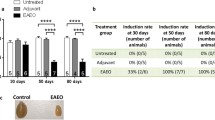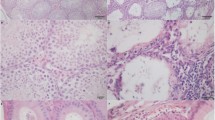Abstract
Testicular germ cell-induced autoimmune orchitis is characterized by inflammatory cell infiltration followed by disturbance of spermatogenesis. Experimental autoimmune orchitis (EAO) is an animal model for human immunological male infertility; delayed-type hypersensitivity (DTH) response plays a key role in its induction. Interleukin-10 (IL-10) is a regulatory cytokine that is critical in preventing organ-specific autoimmune inflammation. To determine the effects on EAO of human IL-10 (hIL-10) gene transfer, C3H/He mice immunized by unilateral testicular injury were administered intramuscular (i.m.) injections of adeno-associated viral (AAV) vector-encoding hIL-10 on the day of immunization. Serum hIL-10 was detected beginning at 1 week postinjection, and peaked at 3 weeks. Histological examinations showed a significantly low incidence of orchitis and disturbance of spermatogenesis in AAV hIL-10-treated mice, and the DTH response to autologous testicular cells was significantly suppressed. Immunohistochemical analysis of IFN-γ and IL-2, T-cell-associated cytokines, in the spleen and testes revealed significantly fewer cytokine-expressing cells after treatment. We conclude that a single i.m. administration of AAV hIL-10 significantly suppresses EAO and hypospermatogenesis by regulating cell-mediated immunity in the testes.





Similar content being viewed by others
References
Sigman M, Lipshultz LI, Howards SS . Evaluation of the subfertile male. In: Lipshultz LI, Howards SS (eds). Infertility in the Male, ed 2, Mosby-Year Book: St Louis, 1991, pp 179–210.
Suominen JJ . Sympathetic auto-immune orchitis. Andrologia 1995; 27: 213–216.
Suominen J, Soderstrom KO . Lymphocyte infiltration in human testicular biopsies. Int J Androl 1982; 5: 461–466.
Andrada JA et al. Immunological studies in patients with mumps orchitis. Andrologia 1977; 9: 207–215.
Sakamoto Y, Matsumoto T, Kumazawa J . Cell-mediated autoimmune response to testis induced by bilateral testicular injury can be suppressed by cyclosporin A. J Urol 1998; 159: 1735–1740.
Sakamoto Y et al. Testicular injury induces cell-mediated autoimmune response to testis. J Urol 1995; 153: 1316–1320.
Itoh M, Hiramine C, Hojo K . A new murine model of autoimmune orchitis induced by immunization with viable syngeneic testicular germ cells alone. I. Immunological and histological studies. Clin Exp Immunol 1991; 83: 137–142.
Dijkmans R, Billiau A . Interferon gamma: a master key in the immune system. Curr Opin Immunol 1988; 1: 269–274.
Cher DJ, Mosmann TR . Two types of murine helper T cell clone. II. Delayed-type hypersensitivity is mediated by TH1 clones. J Immunol 1987; 138: 3688–3694.
Li L, Elliott JF, Mosmann TR . IL-10 inhibits cytokine production, vascular leakage, and swelling during T helper 1 cell-induced delayed-type hypersensitivity. J Immunol 1994; 153: 3967–3978.
Yang Z et al. Suppression of autoimmune diabetes by viral IL-10 gene transfer. J Immunol 2002; 168: 6479–6485.
Goudy K et al. Adeno-associated virus vector-mediated IL-10 gene delivery prevents type 1 diabetes in NOD mice. Proc Natl Acad Sci USA 2001; 98: 13913–13918.
Cua DJ et al. Central nervous system expression of IL-10 inhibits autoimmune encephalomyelitis. J Immunol 2001; 166: 602–608.
Ma Y et al. Inhibition of collagen-induced arthritis in mice by viral IL-10 gene transfer. J Immunol 1998; 161: 1516–1524.
Manno CS et al. AAV-mediated factor IX gene transfer to skeletal muscle in patients with severe hemophilia B. Blood 2003; 101: 2963–2972; (Epub 2002 Dec 19).
Nasu Y, Djavan B, Marberger M, Kumon H . Prostate cancer gene therapy: outcome of basic research and clinical trials. Tech Urol 1999; 5: 185–190.
Rabinowitz JE, Samulski J . Adeno-associated virus expression systems for gene transfer. Curr Opin Biotechnol 1998; 9: 470–475.
Muzyczka N . Use of adeno-associated virus as a general transduction vector for mammalian cells. Curr Top Microbiol Immunol 1992; 158: 97–129.
Song S et al. Sustained secretion of human alpha-1-antitrypsin from murine muscle transduced with adeno-associated virus vectors. Proc Natl Acad Sci USA 1998; 95: 14384–14388.
Kessler PD et al. Gene delivery to skeletal muscle results in sustained expression and systemic delivery of a therapeutic protein. Proc Natl Acad Sci USA 1996; 93: 14082–14087.
Li L et al. Prevention of murine experimental autoimmune orchitis by recombinant human interleukin-6. Clin Immunol 2002; 102: 135–137.
Itoh M et al. Essential pathogenic role for endogenous interferon-gamma (IFN-gamma) during disease onset phase of murine experimental autoimmune orchitis. I. In vivo studies. Clin Exp Immunol 1998; 111: 513–520.
Ablake M et al. Short-term prophylaxis with deoxyspergualin prevents testicular autoimmunity in mice. Eur J Pharmacol 2002; 450: 209–212.
Cua DJ et al. Transgenic interleukin 10 prevents induction of experimental autoimmune encephalomyelitis. J Exp Med 1999; 189: 1005–1010.
Lee MS et al. Pancreatic islet production of murine interleukin-10 does not inhibit immune-mediated tissue destruction. J Clin Invest 1994; 93: 1332–1338.
Kaneko T et al. Proinflammatory effects of exogenously administered IL-10 in experimental autoimmune orchitis. Cytokine 2003; 22: 50–53.
Sakamoto Y, Matsumoto T, Kumazawa J . Establishment of murine model of autoimmune male infertility. Nippon Hinyokika Gakkai Zasshi 1999; 90: 763–768.
Carter LL, Dutton RW . Type 1 and type 2: a fundamental dichotomy for all T-cell subsets. Curr Opin Immunol 1996; 8: 336–342.
Holland G, Zlotnik A . Interleukin-10 and cancer. Cancer Invest 1993; 11: 751–758.
Chiorini JA et al. High-efficiency transfer of the T cell co-stimulatory molecule B7-2 to lymphoid cells using high-titer recombinant adeno-associated virus vectors. Hum Gene Ther 1995; 6: 1531–1541.
Kashiwakura Y et al. Hepatocyte growth factor receptor is a coreceptor for adeno-associated virus type 2 infection. J Virol 2005; 79: 609–614.
Author information
Authors and Affiliations
Appendix A
Appendix A
For transduction efficiency after 48 h incubation with AAV GFP
Rights and permissions
About this article
Cite this article
Watanabe, M., Kashiwakura, Y., Kusumi, N. et al. Adeno-associated virus-mediated human IL-10 gene transfer suppresses the development of experimental autoimmune orchitis. Gene Ther 12, 1126–1132 (2005). https://doi.org/10.1038/sj.gt.3302463
Received:
Accepted:
Published:
Issue Date:
DOI: https://doi.org/10.1038/sj.gt.3302463
- Springer Nature Limited
Keywords
This article is cited by
-
Testicular defense systems: immune privilege and innate immunity
Cellular & Molecular Immunology (2014)
-
Mechanisms of testicular immune privilege
Frontiers in Biology (2011)
-
Potent antitumor effects of combined therapy with a telomerase-specific, replication-competent adenovirus (OBP-301) and IL-2 in a mouse model of renal cell carcinoma
Cancer Gene Therapy (2010)
-
REIC/Dkk-3 overexpression downregulates P-glycoprotein in multidrug-resistant MCF7/ADR cells and induces apoptosis in breast cancer
Cancer Gene Therapy (2009)
-
Direct and distant antitumor effects of a telomerase-selective oncolytic adenoviral agent, OBP-301, in a mouse prostate cancer model
Cancer Gene Therapy (2008)




